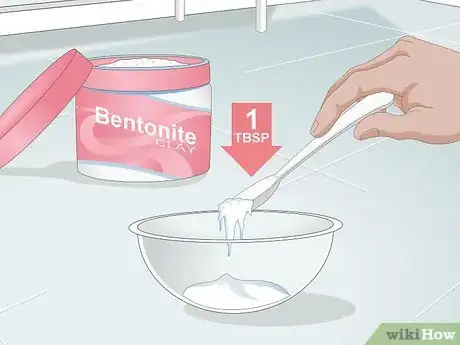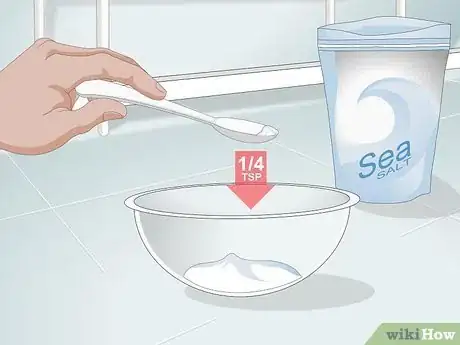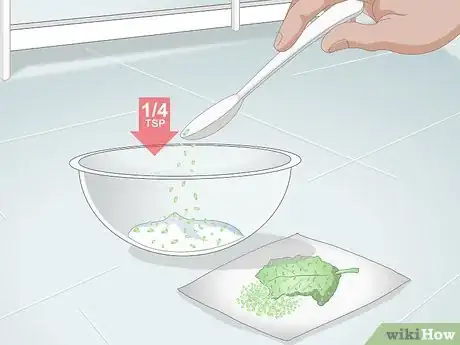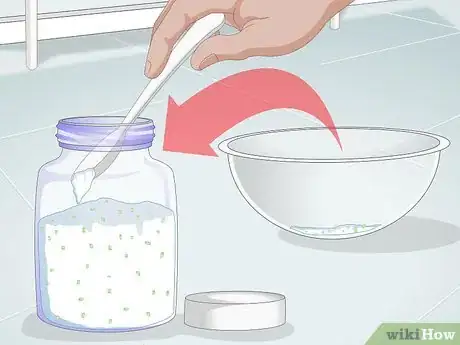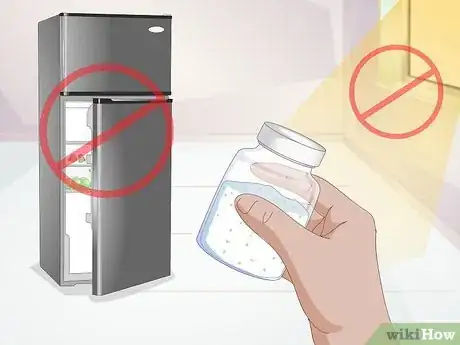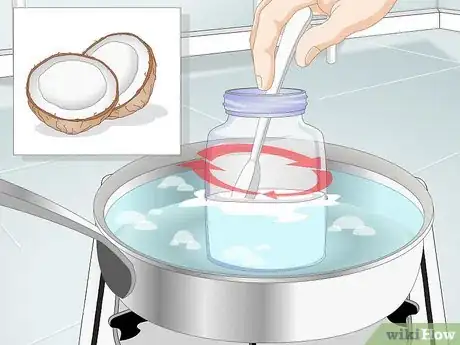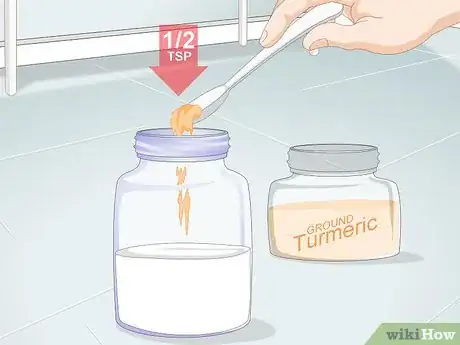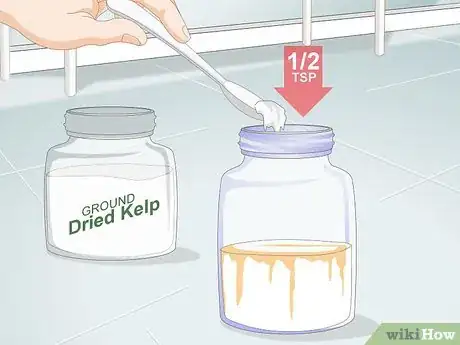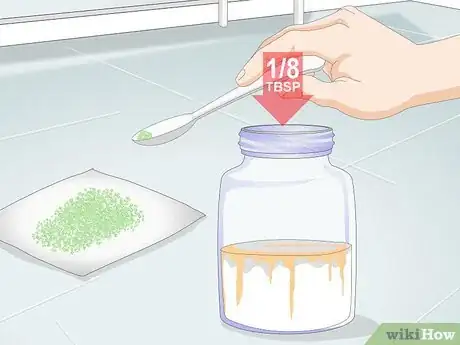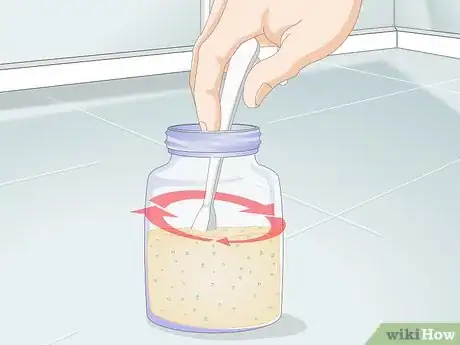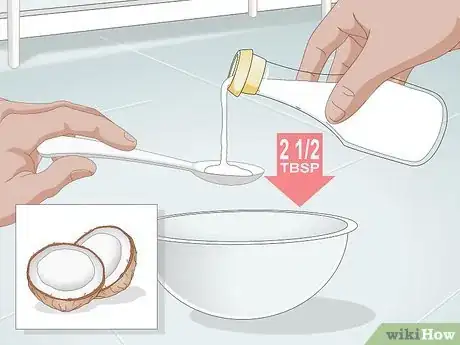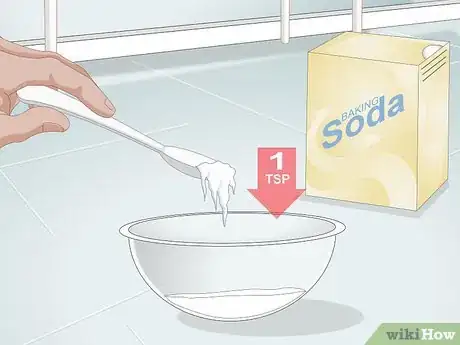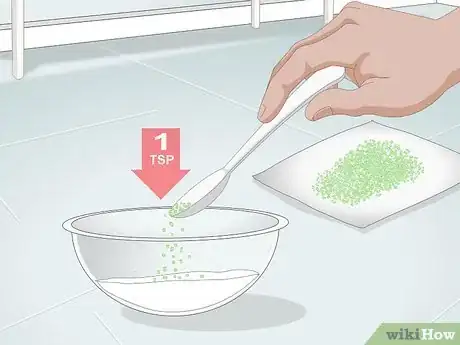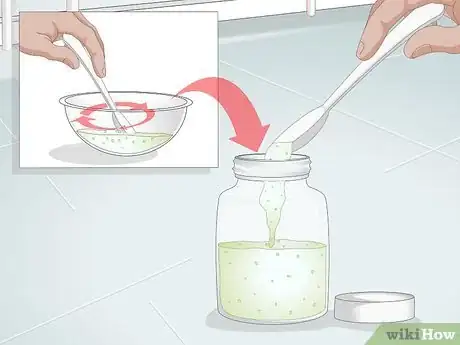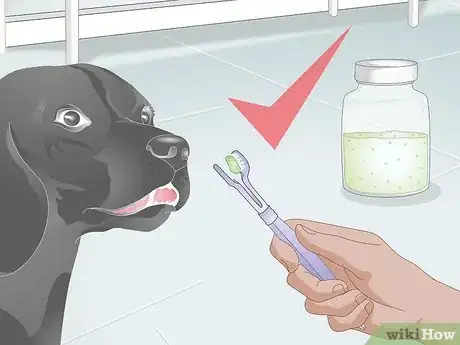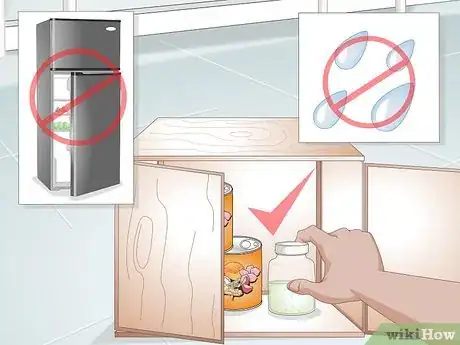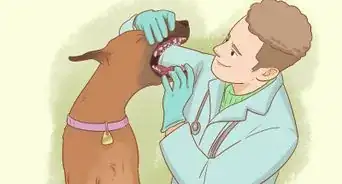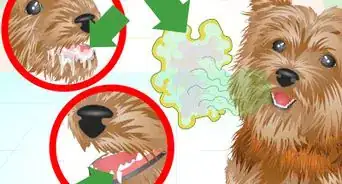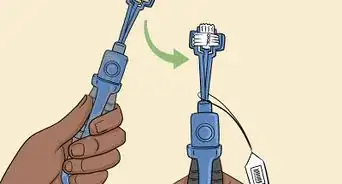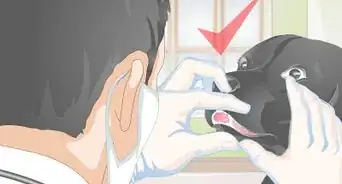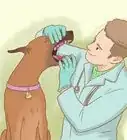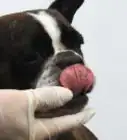This article was co-authored by Pippa Elliott, MRCVS. Dr. Elliott, BVMS, MRCVS is a veterinarian with over 30 years of experience in veterinary surgery and companion animal practice. She graduated from the University of Glasgow in 1987 with a degree in veterinary medicine and surgery. She has worked at the same animal clinic in her hometown for over 20 years.
This article has been viewed 29,331 times.
Brushing your dog's teeth is important to your dog's dental health. Much like humans, dogs can suffer from cavities and bad breath. Unfortunately, many store-bought toothpastes are either very expensive, or simply so bad-tasting, that they make brushing more of a hassle than it already is. Making your own toothpaste is a great way to control exactly what goes into your dog's dental care.
Steps
Using Coconut Oil and Bentonite Clay
-
1Melt 3 tablespoons of coconut oil in a small, microwave-safe bowl. The coconut oil will give the toothpaste a smooth, thick consistency. It is also naturally antibacterial, and may help fight bad breath and cavities. You can melt the coconut oil in the microwave or in a double-boiler. Melting the coconut oil first will help the rest of the ingredients mix into it more smoothly.
- To melt it in the microwave: heat the coconut oil for 10 seconds, then give it a stir. If the coconut oil still isn't melted, heat it for another 5 to 10 seconds.
- To melt it in a double-boiler: fill a small saucepan with 1 to 2 inches (2.54 to 5.08 centimeters) of water, and place a glass bowl on top. Put the coconut oil into the bowl, and stir it until it melts.
-
2Stir in 1 tablespoon of bentonite clay. Bentonite clay acts as a binder. It may also help remove food residue from around your dog's teeth and gums.
- Bentonite clay may react with certain medications. If your dog is taking any medications, consult your veterinarian first.
Advertisement -
3Stir in ¼ teaspoon of finely-ground sea salt. Sea salt is gently abrasive, so it will help scrub your dog's teeth clean. It may also help neutralize any bacteria-forming acids in your dog's mouth. This can help prevent bad breath and tooth decay.
- Make sure that the sea salt is finely-ground.
-
4Consider adding ¼ teaspoon of finely-ground dried mint or parsley. These will freshen up your dog's breath. To help distribute the herbs more evenly throughout the toothpaste, grind the herbs up using an herb grinder, coffee grinder, or a mortar and pestle.
- If you are using a coffee grinder, make sure that it is perfectly clean. It would be even better to use one reserved specifically for grinding herbs. Coffee is toxic to dogs.
-
5Scoop the toothpaste into a small, glass jar with a tight-fitting lid. Avoid using a plastic jar, as it can leach chemicals into the toothpaste overtime.
-
6Wait for the toothpaste to harden again before you use it. Store the toothpaste away from heat and light. Avoid storing it in the fridge, however, or it will harden too much. The toothpaste should last a few months. If it starts to look or smell strange before that, however, toss it out.
- If the toothpaste becomes too hard to scoop, place the jar into a small bowl filled with hot water for a few minutes, then stir the toothpaste.
Using Coconut Oil and Turmeric
-
1Melt 1 cup (225 grams) of coconut oil in a hot water bath. The coconut oil will act as a base for your toothpaste. It is also naturally antibacterial, so it can help fight against cavities and bad breath. To melt the coconut oil:
- Put the coconut oil into a jar, then place the jar into a saucepan.
- Fill the saucepan with enough water so that the water is level with the oil.
- Set the heat to medium, and stir the coconut oil until it melts.
- Take the jar out of the saucepan once the coconut oil has melted.
-
2Add ½ teaspoon of ground turmeric. Turmeric is naturally antibacterial, so it can help kill off bacteria. It is also a natural whitener. It may also help prevent plaque.
-
3Add ½ of ground, dried kelp. Kelp helps remove plaque. It is also naturally antibacterial and filled with beneficial minerals.
-
4Add ⅛ tablespoon of dried parsley flakes. Parsley can not only help freshen up your dog's breath, but it can help kill of bacteria in his or her mouth. It is full of vitamins and minerals, which may help promote your dog's dental health. If you'd like, you can grind the parsley flakes up further using an herb grinder, coffee grinder, or a mortar and pestle.
- If you plan on using a coffee grinder, make sure that it is clean. It would be better to use one reserved for grinding herbs, as coffee is toxic to dogs.
-
5Stir the ingredients together until everything is evenly combined. At this point, you can pour the toothpaste into a clean jar, or you can leave it in its current jar. If you plan on pouring the oil into a new jar, consider pouring it into smaller jars so that it will be easier to use.
- The jars must be made out of glass, as plastic ones can leach chemicals over time.
Using Coconut Oil and Baking Soda
-
1Place 2½ tablespoons of coconut oil into a small bowl. The coconut oil will serve as the base for your toothpaste. It is also natural antibacterial, and it may help ward off cavities and bad breath.
-
2Add 1 teaspoon of baking soda. Baking soda is mildly abrasive. It will help gently scrub away tartar and plaque.
-
3Add 1 teaspoon of dried parsley. This will help freshen your dog's breath as was as neutralize bad odor. If you'd like, you can grind the parsley up further using an herb grinder, coffee grinder, or a mortar and pestle.
- If you choose to use a coffee grinder, make sure that it is clean. It would be better to use a grinder that is dedicated to herbs, as coffee is toxic to dogs.
-
4Consider adding 2 drops of peppermint essential oil. While not completely necessary, this oil will help further freshen up your dog's breath. Use only pure, alcohol-free essential oil. It must not be blended with alcohols or carrier oils.
-
5Stir everything together, then scoop into a small, glass jar with a tight-fitting lid. The jar must be made out of glass, as plastic may leach chemicals into the toothpaste over time.
-
6Use the toothpaste with care. Baking soda is great at cleaning teeth, but it can cause your dog's stomach to become upset if he or she eats it. Use only small amounts when brushing your dog's teeth, and always keep the jar tightly-closed and out of his or her reach to prevent any "snacking."[1]
-
7Store the toothpaste in a cool, dry place. Avoid keeping it in the refrigerator, or it might harden too much. If the toothpaste does become too hard, you can soften it up a little by placing the jar into a bowl filled with hot water for a few minutes.
Expert Q&A
-
QuestionCan I use human toothpaste for my dog?
 Pippa Elliott, MRCVSDr. Elliott, BVMS, MRCVS is a veterinarian with over 30 years of experience in veterinary surgery and companion animal practice. She graduated from the University of Glasgow in 1987 with a degree in veterinary medicine and surgery. She has worked at the same animal clinic in her hometown for over 20 years.
Pippa Elliott, MRCVSDr. Elliott, BVMS, MRCVS is a veterinarian with over 30 years of experience in veterinary surgery and companion animal practice. She graduated from the University of Glasgow in 1987 with a degree in veterinary medicine and surgery. She has worked at the same animal clinic in her hometown for over 20 years.
Veterinarian No, human toothpaste should not be used on dogs. This is because of the fluoride content in human toothpaste, which is toxic to dogs if swallowed.
No, human toothpaste should not be used on dogs. This is because of the fluoride content in human toothpaste, which is toxic to dogs if swallowed. -
QuestionWhat can I brush my dog's teeth with?
 Pippa Elliott, MRCVSDr. Elliott, BVMS, MRCVS is a veterinarian with over 30 years of experience in veterinary surgery and companion animal practice. She graduated from the University of Glasgow in 1987 with a degree in veterinary medicine and surgery. She has worked at the same animal clinic in her hometown for over 20 years.
Pippa Elliott, MRCVSDr. Elliott, BVMS, MRCVS is a veterinarian with over 30 years of experience in veterinary surgery and companion animal practice. She graduated from the University of Glasgow in 1987 with a degree in veterinary medicine and surgery. She has worked at the same animal clinic in her hometown for over 20 years.
Veterinarian There are many commercial dog toothpastes available. If you want the very best, look for a pet toothpaste accredited by the Veterinary Oral Health Council (VOHC) as these products are clinically proven to work.
There are many commercial dog toothpastes available. If you want the very best, look for a pet toothpaste accredited by the Veterinary Oral Health Council (VOHC) as these products are clinically proven to work. -
QuestionHow can I clean my dog's teeth naturally?
 Pippa Elliott, MRCVSDr. Elliott, BVMS, MRCVS is a veterinarian with over 30 years of experience in veterinary surgery and companion animal practice. She graduated from the University of Glasgow in 1987 with a degree in veterinary medicine and surgery. She has worked at the same animal clinic in her hometown for over 20 years.
Pippa Elliott, MRCVSDr. Elliott, BVMS, MRCVS is a veterinarian with over 30 years of experience in veterinary surgery and companion animal practice. She graduated from the University of Glasgow in 1987 with a degree in veterinary medicine and surgery. She has worked at the same animal clinic in her hometown for over 20 years.
Veterinarian Be very careful because many of the natural toothpaste remedies available online have the potential to be toxic. Even 'natural' ingredients, such as essential oils, can be dangerous if ingested and this is highly likely to happen when you put something in a dog's mouth. If you don't want to use a commercial product, then use a soft toothbrush and water, since the mechanical action will have some benefit.
Be very careful because many of the natural toothpaste remedies available online have the potential to be toxic. Even 'natural' ingredients, such as essential oils, can be dangerous if ingested and this is highly likely to happen when you put something in a dog's mouth. If you don't want to use a commercial product, then use a soft toothbrush and water, since the mechanical action will have some benefit.
Warnings
- Coconut oil becomes liquid if stored out for too long.⧼thumbs_response⧽
- Do not let your dog eat the toothpaste. Although the ingredients by themselves are not harmful, eating a whole jar of them can result in an upset stomach!⧼thumbs_response⧽
- Never use human toothpaste for dogs. It contains fluoride and Xylitol, both of which can be fatal to dogs.[3] [4]⧼thumbs_response⧽
Things You'll Need
Using Coconut Oil and Bentonite Clay
- 3 tablespoons coconut oil
- 1 tablespoon bentonite clay
- ¼ teaspoon finely-ground sea salt
- Small glass bowl
- Spoon or stir stick
- Small glass jar
Using Coconut Oil and Turmeric
- 1 cup (225 grams) coconut oil.
- ½ teaspoon ground turmeric
- ½ teaspoon dried, ground kelp
- ⅛ tablespoon dried parsley flakes
- Small glass bowl
- Spoon or stir stick
- Small glass jar
Using Coconut Oil and Baking Soda
- 2½ tablespoons coconut oil
- 1 teaspoon baking soda
- 1 teaspoon organic, dried parsley
- 2 drops pure peppermint essential oil (must be alcohol-free)
- Small glass bowl
- Spoon or stir stick
- Small glass jar
References
About This Article
To make dog toothpaste with coconut oil and bentonite clay, start by melting 3 tablespoons of coconut oil in a small bowl in your microwave. Next, stir in 1 tablespoon of bentonite clay and ¼ teaspoon of finely-ground sea salt. To freshen up your dog's breath, you can also add ¼ teaspoon of finely-ground dried mint or parsley. Then, scoop the mixture into a small, glass jar with a tight-fitting lid and wait for the toothpaste to harden before you use it. For tips on making dog toothpaste with other ingredients, read on!

